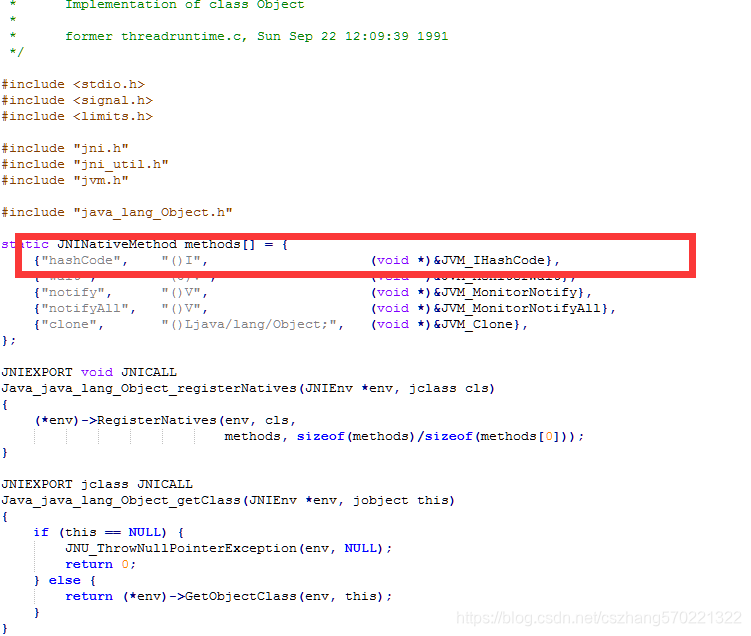最近几天在看HashMap的源码:
/**
* Returns a hash code value for the object. This method is
* supported for the benefit of hash tables such as those provided by
* {@link java.util.HashMap}.
* <p>
* The general contract of {@code hashCode} is:
* <ul>
* <li>Whenever it is invoked on the same object more than once during
* an execution of a Java application, the {@code hashCode} method
* must consistently return the same integer, provided no information
* used in {@code equals} comparisons on the object is modified.
* This integer need not remain consistent from one execution of an
* application to another execution of the same application.
* <li>If two objects are equal according to the {@code equals(Object)}
* method, then calling the {@code hashCode} method on each of
* the two objects must produce the same integer result.
* <li>It is <em>not</em> required that if two objects are unequal
* according to the {@link java.lang.Object#equals(java.lang.Object)}
* method, then calling the {@code hashCode} method on each of the
* two objects must produce distinct integer results. However, the
* programmer should be aware that producing distinct integer results
* for unequal objects may improve the performance of hash tables.
* </ul>
* <p>
* As much as is reasonably practical, the hashCode method defined by
* class {@code Object} does return distinct integers for distinct
* objects. (This is typically implemented by converting the internal
* address of the object into an integer, but this implementation
* technique is not required by the
* Java™ programming language.)
*
* @return a hash code value for this object.
* @see java.lang.Object#equals(java.lang.Object)
* @see java.lang.System#identityHashCode
*/
public native int hashCode();
看到hashCode的源码,便想去看看native的实现:
下载OpenJDJ7:http://download.java.net/openjdk/jdk7/promoted/b147/openjdk-7-fcs-src-b147-27_jun_2011.zip
J:\MAKER\Java源码\openjdk-7-fcs-src-b147-27_jun_2011\openjdk\jdk\src\share\classes\java\lang>javah -jni java.lang.Object得到 java_lang_Object.h文件,其中hashCode如下
/*
* Class: java_lang_Object
* Method: hashCode
* Signature: ()I
*/
JNIEXPORT jint JNICALL Java_java_lang_Object_hashCode
(JNIEnv *, jobject);查百度什么是JNI:JNI是Java Native Interface的缩写,它提供了若干的API实现了Java和其他语言的通信(主要是C&C++)
便想,既然底层用的C,那为什么还能跨平台(现在感觉跨平台这个特性其实已经不怎么用了),一想高斯林老爷子用了一个JVM,这样只要不同操作系统对应的JVM里有相应的方法实现就可以了。
然后可以去看我这篇JNI HelloWorld :https://mp.csdn.net/postedit/84790791
我们找到openjdk\jdk\src\share\native\java\lang\Object.c,这是对Object类的实现。

然而hashcode函数是以指针形式在JVM中实现的。
在J:\MAKER\Java源码\openjdk-7-fcs-src-b147-27_jun_2011\openjdk\jdk\src\share\javavm\export\jvm.h中有方法
JVM_IHashCode(JNIEnv *env, jobject obj);
然后找到.h的实现.cpp,J:\MAKER\Java源码\openjdk-7-fcs-src-b147-27_jun_2011\openjdk\hotspot\src\share\vm\prims\jvm.cpp
// java.lang.Object ///
JVM_ENTRY(jint, JVM_IHashCode(JNIEnv* env, jobject handle))
JVMWrapper("JVM_IHashCode");
// as implemented in the classic virtual machine; return 0 if object is NULL
return handle == NULL ? 0 : ObjectSynchronizer::FastHashCode (THREAD, JNIHandles::resolve_non_null(handle)) ;
JVM_END然后他又调用ObjectSynchronizer::FastHashCode方法了,
ObjectSynchronizer::fashHashCode()方法在 openjdk\hotspot\src\share\vm\runtime\synchronizer.cpp 文件中实现,其核心代码实现如下所示:
intptr_t ObjectSynchronizer::FastHashCode (Thread * Self, oop obj) {
if (UseBiasedLocking) {
// NOTE: many places throughout the JVM do not expect a safepoint
// to be taken here, in particular most operations on perm gen
// objects. However, we only ever bias Java instances and all of
// the call sites of identity_hash that might revoke biases have
// been checked to make sure they can handle a safepoint. The
// added check of the bias pattern is to avoid useless calls to
// thread-local storage.
if (obj->mark()->has_bias_pattern()) {
// Box and unbox the raw reference just in case we cause a STW safepoint.
Handle hobj (Self, obj) ;
// Relaxing assertion for bug 6320749.
assert (Universe::verify_in_progress() ||
!SafepointSynchronize::is_at_safepoint(),
"biases should not be seen by VM thread here");
BiasedLocking::revoke_and_rebias(hobj, false, JavaThread::current());
obj = hobj() ;
assert(!obj->mark()->has_bias_pattern(), "biases should be revoked by now");
}
}
// hashCode() is a heap mutator ...
// Relaxing assertion for bug 6320749.
assert (Universe::verify_in_progress() ||
!SafepointSynchronize::is_at_safepoint(), "invariant") ;
assert (Universe::verify_in_progress() ||
Self->is_Java_thread() , "invariant") ;
assert (Universe::verify_in_progress() ||
((JavaThread *)Self)->thread_state() != _thread_blocked, "invariant") ;
ObjectMonitor* monitor = NULL;
markOop temp, test;
intptr_t hash;
markOop mark = ReadStableMark (obj);
// object should remain ineligible for biased locking
assert (!mark->has_bias_pattern(), "invariant") ;
if (mark->is_neutral()) {
hash = mark->hash(); // this is a normal header
if (hash) { // if it has hash, just return it
return hash;
}
hash = get_next_hash(Self, obj); // allocate a new hash code
temp = mark->copy_set_hash(hash); // merge the hash code into header
// use (machine word version) atomic operation to install the hash
test = (markOop) Atomic::cmpxchg_ptr(temp, obj->mark_addr(), mark);
if (test == mark) {
return hash;
}
// If atomic operation failed, we must inflate the header
// into heavy weight monitor. We could add more code here
// for fast path, but it does not worth the complexity.
} else if (mark->has_monitor()) {
monitor = mark->monitor();
temp = monitor->header();
assert (temp->is_neutral(), "invariant") ;
hash = temp->hash();
if (hash) {
return hash;
}
// Skip to the following code to reduce code size
} else if (Self->is_lock_owned((address)mark->locker())) {
temp = mark->displaced_mark_helper(); // this is a lightweight monitor owned
assert (temp->is_neutral(), "invariant") ;
hash = temp->hash(); // by current thread, check if the displaced
if (hash) { // header contains hash code
return hash;
}
// WARNING:
// The displaced header is strictly immutable.
// It can NOT be changed in ANY cases. So we have
// to inflate the header into heavyweight monitor
// even the current thread owns the lock. The reason
// is the BasicLock (stack slot) will be asynchronously
// read by other threads during the inflate() function.
// Any change to stack may not propagate to other threads
// correctly.
}
// Inflate the monitor to set hash code
monitor = ObjectSynchronizer::inflate(Self, obj);
// Load displaced header and check it has hash code
mark = monitor->header();
assert (mark->is_neutral(), "invariant") ;
hash = mark->hash();
if (hash == 0) {
hash = get_next_hash(Self, obj);
temp = mark->copy_set_hash(hash); // merge hash code into header
assert (temp->is_neutral(), "invariant") ;
test = (markOop) Atomic::cmpxchg_ptr(temp, monitor, mark);
if (test != mark) {
// The only update to the header in the monitor (outside GC)
// is install the hash code. If someone add new usage of
// displaced header, please update this code
hash = test->hash();
assert (test->is_neutral(), "invariant") ;
assert (hash != 0, "Trivial unexpected object/monitor header usage.");
}
}
// We finally get the hash
return hash;
}既然要看Hashcode函数,我知道java中字符的hashcode是其Ascii码,这里看下为什么。
可以看到,实现用了很多种方法,我C语言很少接触,全然看不懂
//TODO 我去看下JAVA编程思想。





















 258
258











 被折叠的 条评论
为什么被折叠?
被折叠的 条评论
为什么被折叠?








